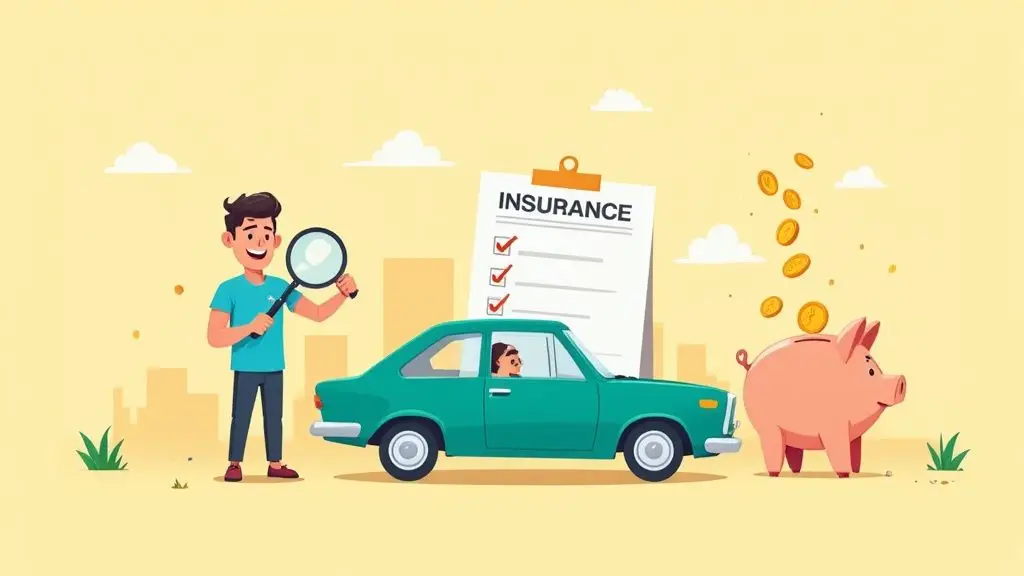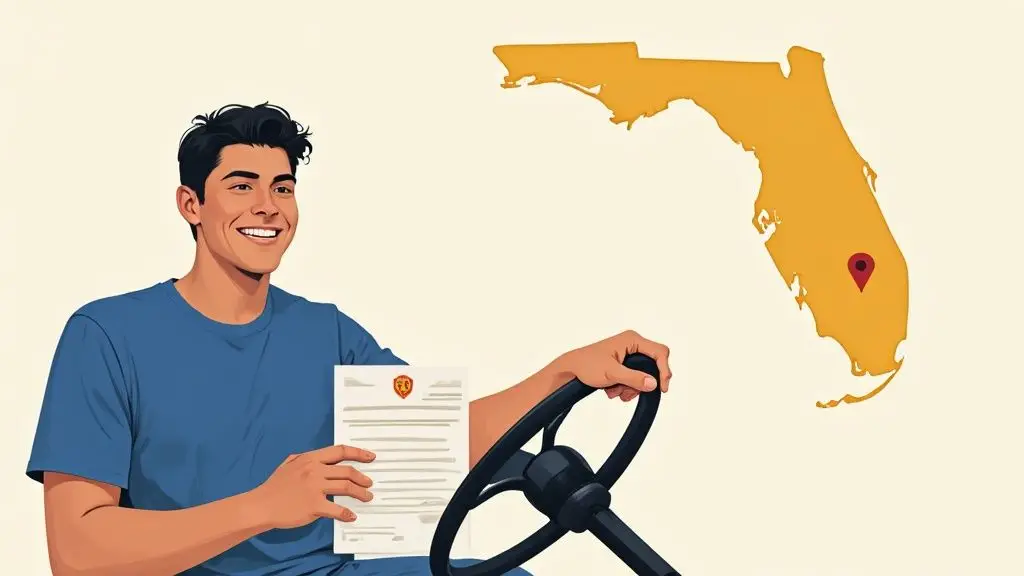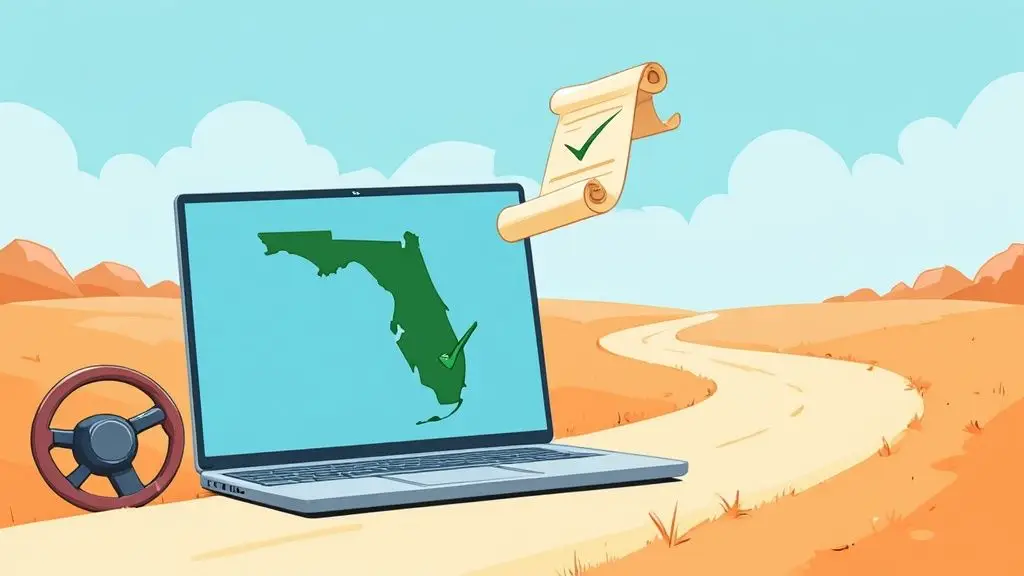When you glance at your Florida driver’s license, you might see the words “Safe Driver” printed on it. This isn’t just a random label; it’s the state’s official nod to your responsible driving habits. Think of it as a seal of approval from the Florida Department of Highway Safety and Motor Vehicles (FLHSMV), marking you as someone who consistently follows the rules of the road.
This designation is more than just for show—it often unlocks real-world benefits, like some very welcome insurance discounts.
What Does “Safe Driver” Status Actually Mean?
At its core, the “Safe Driver” status is a straightforward reflection of your track record behind the wheel. It’s a quick, verifiable signal to law enforcement and insurance providers that you’re considered a low-risk driver.
Imagine it like getting a high credit score for your driving. It’s a simple, clear indicator that you’ve been responsible and haven’t run into trouble.
Your Driving Record in Action
This official notation is given to drivers who keep their records clean from traffic violations for a specific period—typically 3 years. It’s proof that you’ve managed to avoid at-fault accidents and serious moving violations that add points to your license.
To give you a quick overview, here’s a simple breakdown of what the designation involves.
Florida Safe Driver Status At a Glance
| Aspect | Description |
|---|---|
| What It Is | An official notation on your Florida driver’s license recognizing a clean driving record. |
| Eligibility | Typically requires 3 consecutive years without any moving violations or at-fault accidents. |
| Key Benefits | Potential for lower insurance premiums, point avoidance, and a simplified license renewal process. |
This table sums it up nicely. The program is designed to reward drivers who make our roads safer for everyone.
Putting It Into Practice
So, what does having this status do for you on a day-to-day basis? For starters, when it’s time to renew your license, being a designated Safe Driver often lets you do it online, saving you a dreaded trip to the DMV.
The whole point of the program is to incentivize good behavior. The FLHSMV wants to give clear advantages to drivers who steer clear of accumulating violations. If you’re curious about the penalties for infractions, you can learn more about how points on a Florida license work.
The “Safe Driver” notation is essentially the state’s stamp of approval. It tells others that you have successfully avoided at-fault accidents, serious moving violations, and other infractions that put public safety at risk.
Ultimately, this system creates a clear line between conscientious drivers and those with a history of tickets and crashes. It’s a smart way to encourage everyone to drive more carefully, making Florida’s roads safer for all of us.
How to Qualify for the Florida Safe Driver Designation
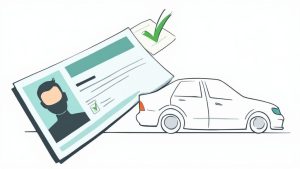
Earning that “Safe Driver” stamp on your Florida license isn’t a mystery. It’s not about being a perfect driver, but a consistent one. The state has laid out a clear path for drivers who prove they can be trusted on the road.
The biggest hurdle is maintaining a clean driving record for a continuous three-year period. Think of it as a three-year window where the Florida Department of Highway Safety and Motor Vehicles (FLHSMV) is watching. Any serious slip-ups can reset the clock, and you’ll have to start that three-year wait all over again.
This isn’t just an informal policy; it’s baked into state law. Chapter 322 of the Florida Statutes sets the standard: if you can go three years without any serious moving violations, you’ve earned the right to be recognized as a “Safe Driver.” It’s a simple, but effective, system for rewarding good behavior.
What Does a “Clean Record” Actually Mean?
So, what does the FLHSMV consider a “clean record”? They aren’t looking for parking tickets or other minor, non-moving issues. Their focus is squarely on violations that point to risky behavior behind the wheel.
These are the big things that will immediately disqualify you:
- At-Fault Accidents: If you cause a collision, your three-year countdown resets to zero. No exceptions.
- Moving Violations: This is the broad category that catches most people. Things like speeding, running a red light, or making an unsafe lane change will knock you out of the running.
- License Points: Any traffic ticket that adds points to your license is a deal-breaker.
The fastest way to lose eligibility is to rack up points on your license. Each point is a signal to the state that you’re a higher-risk driver, making you the exact opposite of what they’re looking to reward.
If you’re not sure where you stand, it’s a smart move to pull your own driving history. Our guide explains how to check your driving record in Florida so you can see your record exactly as the FLHSMV sees it. This is the first step to figuring out if you’re on track to earn that prized designation.
The Perks: What’s In It For You?

This is where all that careful driving really starts to pay dividends. Having the “Safe Driver” designation on your Florida license isn’t just for show—it’s your ticket to some very real, tangible rewards, starting with your car insurance bill.
Think about it from an insurance company’s perspective. Their entire business model is built on managing risk. A driver with a spotless, state-verified record is, statistically speaking, a much safer bet. That “Safe Driver” notation is an official thumbs-up from the FLHSMV, telling insurers you’re a low-risk client.
That gives you some serious bargaining power. When you’re shopping for a new policy or renewing an old one, pointing out your Safe Driver status can lead to some significant discounts. Many insurers offer specific “claims-free” or “safe driver” deals that can knock up to 25% or even more off your premiums.
It’s Not Just About the Money
The savings are fantastic, but the practical advantages make life a whole lot easier, too. One of the best perks is a far simpler license renewal process.
Instead of blocking off half a day for a trip to the DMV, many safe drivers can renew their license completely online. It’s a huge time-saver, turning what is usually a major hassle into a five-minute task you can do from your couch.
The benefits even carry over into other situations on the road:
- A Signal of Good Character: During a minor traffic stop, that “Safe Driver” status can subtly work in your favor. It shows law enforcement that you have a proven track record of being responsible.
- Potential for Leniency: While it’s certainly not a “get out of jail free” card, it might just be the thing that convinces an officer to give you a warning for a minor infraction instead of a ticket. This is always at their discretion, of course.
The “Safe Driver” status transforms your license from a simple ID into a testament to your reliability on the road. It tells insurance carriers you are a good investment and tells the state you are a responsible member of the driving community.
Knowing how to lower auto insurance rates is key for any driver, and keeping a clean record is one of the most direct ways to do it. Your good habits are rewarded with lower bills and fewer headaches—a win-win for any Florida driver.
Common Violations That Will Cost You This Status
Getting that “Safe Driver” status on your Florida license feels great, but it’s not a permanent award. Think of it like a clean slate you have to keep clean. One mistake, one bad day on the road, and you could find yourself starting that three-year qualification period all over again.
So, what are the tripwires? The biggest one is simple: any traffic ticket that adds points to your license.
This covers all the usual suspects—speeding, rolling through a stop sign, or an illegal U-turn. These are called moving violations because they happen while your car is, well, moving, and they show you weren’t operating the vehicle safely. Getting tagged for one of these is an automatic disqualification.
Being found at-fault for an accident will also get your Safe Driver status revoked. If the Florida Highway Safety and Motor Vehicles (FLHSMV) determines you caused the crash, you can say goodbye to the designation.
The Big Ones: Instant Disqualifiers
While any moving violation will reset the clock, some offenses are so serious they’ll get your status pulled immediately, no questions asked. These aren’t minor slip-ups; they represent a major disregard for safety.
- Driving Under the Influence (DUI): This is a non-negotiable. An arrest for driving while impaired by alcohol or drugs is an immediate deal-breaker.
- Reckless Driving: This isn’t just a mistake; it’s driving in a way that shows a deliberate disregard for everyone else’s safety. It’s the polar opposite of being a “safe driver.”
- Major Speeding: We’re not talking about 5 mph over. If you’re caught going 30 mph or more over the speed limit, you’re in a category of risk that automatically disqualifies you.
This infographic breaks down the basic give-and-get of the program—what you need to do and what you stand to gain.
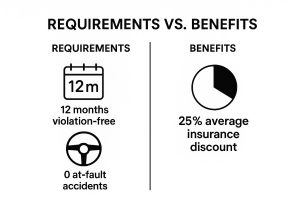
As you can see, keeping that record clean isn’t just about pride; it directly impacts your wallet through things like lower insurance premiums.
Violations Impacting Your Safe Driver Status
To give you a clearer picture, here’s a quick breakdown of common violations and how they can torpedo your Safe Driver status.
| Violation Type | Points Assessed (Typical) | Impact on Safe Driver Status |
|---|---|---|
| Speeding (under 15 mph over) | 3 points | Disqualified. Resets 3-year clock. |
| Running a Red Light | 4 points | Disqualified. Resets 3-year clock. |
| Following Too Closely | 3 points | Disqualified. Resets 3-year clock. |
| Reckless Driving | 4 points | Disqualified. Immediate removal of status. |
| At-Fault Accident | Varies (3-6 points) | Disqualified. Removal of status. |
Ultimately, the path to keeping your status is straightforward: avoid any ticket that adds points. Every violation, no matter how small it seems, puts your hard-earned benefits at risk.
Let’s Bust Some “Safe Driver” Myths

When it comes to the “Safe Driver” status on a Florida license, there’s a lot of chatter and bad advice floating around. Getting the facts straight isn’t just about peace of mind—it can save you from costly mistakes.
So, let’s clear the air and debunk a few of the biggest myths.
Separating Fact from Fiction
The most common point of confusion? What kind of ticket actually dings your record. I’ve heard from countless drivers who are convinced a simple parking ticket will reset their three-year clean streak.
Good news: that’s not true. The Florida Department of Highway Safety and Motor Vehicles (FLHSMV) cares about moving violations. These are the infractions that happen while your car is in motion and add points to your license. A parking ticket is a non-moving violation, so you can breathe easy on that front.
Here are a few other common misconceptions we need to tackle:
- Myth: “My ‘Safe Driver’ status is like a get-out-of-jail-free card. Cops won’t pull me over.”
- Reality: Think of it as a reward for your past, not a shield for your future. If you’re caught speeding, you’re still getting a ticket. An officer enforces the law based on what they see, not the text on your license.
- Myth: “If I get a ticket, I’ll just take a driving course to wipe it clean and keep my status.”
- Reality: Not quite. A Basic Driver Improvement course is great for preventing points from being added to your license, but the violation itself doesn’t just vanish. The FLHSMV still sees the infraction on your record, and that’s usually enough to disqualify you from the program.
At its heart, the Safe Driver program is about rewarding consistently safe behavior. It’s not about being a flawless driver, but about avoiding the kind of risky mistakes that rack up points and put others in danger.
Here is the rewritten section, designed to sound natural and human-written:
It’s Not Just About Driving—It’s About a Secure ID
You might think the “Safe Driver” status on your license is just a pat on the back for good driving. While it is that, it’s also a key part of Florida’s much bigger goal: creating a rock-solid, trustworthy ID system for everyone.
Think of it this way: your driving record is your resume, proving you’re a responsible person behind the wheel. Your physical license, on the other hand, is the verified ID that proves you are actually that person. In Florida, these two ideas are inseparable. A fake ID in the hands of a reckless driver is a serious public safety risk, and that’s why the state has gone to great lengths to make licenses harder to forge.
Seriously Advanced Security
Back in August 2017, Florida started rolling out new driver’s licenses packed with anti-fraud technology. So, when your license says “Safe Driver,” it means two things: you’ve earned that status with a clean record, and you’re holding a highly secure credential that businesses and authorities can trust. You can learn more about the advanced security features of new Florida licenses and how they keep your identity safe.
These aren’t just your average plastic cards. They include some pretty cool features:
- Tactile Text and Images: Run your finger over the card. You can actually feel some of the text and images, a detail that’s incredibly difficult for counterfeiters to copy.
- Color-Shifting Ink: Look for graphics like the state seal. When you tilt the card in the light, the colors will actually change.
- Hidden UV Features: Under a black light, special patterns and images magically appear. It’s a feature you’ll never see, but it’s a powerful tool for verification.
Your “Safe Driver” status is printed on one of the most secure documents the state can issue. It’s a way of locking in your hard-earned reputation, tying your proven responsibility as a driver directly to your verified identity.
This deep connection between safe driving and secure identification ensures that the badge of honor you earned can’t be easily faked, making it a truly reliable symbol of a trustworthy Floridian.
Common Questions About Florida’s Safe Driver Status
It’s totally normal to have questions about your driving record and what it all means. Let’s break down some of the most common things people ask about the “Safe Driver” status on their Florida license.
I Got a Ticket. How Long Until I Can Get My Safe Driver Status Back?
This is a tough one, but if a moving violation knocks you out of the Safe Driver club, you’re essentially starting over. You’ll need to keep a completely clean driving record for three straight years from the date of that last conviction to qualify again.
Think of it as a probationary period. The state wants to see a long-term pattern of responsible driving before putting that seal of approval back on your license.
Will Going to Traffic School Save My Safe Driver Status?
Here’s where a lot of drivers get tripped up. Yes, you should absolutely consider a state-approved driver improvement course to avoid getting points on your license after a ticket. It’s a smart move.
But—and this is a big but—the violation itself doesn’t disappear from your official driving history.
The FLHSMV can still see the original infraction, even if you successfully kept the points off. So, while traffic school is fantastic for your record and insurance rates, the violation will almost always disqualify you from the Safe Driver program and reset that three-year clock.
Does My Florida Safe Driver Status Mean Anything in Other States?
Unfortunately, no. This designation is a Florida-only perk. The benefits, like smoother renewals and those valuable insurance discounts, are recognized here at home.
Other states have their own rules and programs for rewarding good drivers, and they won’t recognize the “Safe Driver” note on your Florida license.
How Do I Check My Driving Record to See if I Qualify?
Finding out is simple. You can order your official driving record right from the Florida Highway Safety and Motor Vehicles (FLHSMV) website.
This report will show you a complete history of any violations and will be the official source for confirming whether you’re eligible for the Safe Driver program.
If a recent ticket is threatening your record, our state-approved online Basic Driver Improvement course at BDISchool can help you keep the points off. Find out more at https://bdischool.com.
